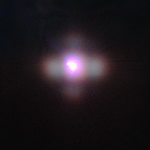Are there any hobby grade laser beam profilers on the market? Ones that would give a picture, such as this the picture below, that costs under $1000 ?

I know I posted before about a beam profiler, but in my pursuit of profiling my own beams, I figured out a way to get a very nice beam profile image by using what is basically a linear CCD. Now it only gives a line, but i'm thinking of using a stepper motor, or something, to move it back and forth to get the whole image. I did this manually with the sensor and just moved the laser beam back and forth over the sensor and it gave a surprisingly good output.
I know LPM's are very popular, and I would think beam profiles are of interest as well, but not many talk or post about them, perhaps because the cheapest one I found was $2000. I was thinking of spending the time to try turn my idea into a product, but i'm not sure enough people even want laser beam profilers. If it could be made for under $300, would that be of interest to anyone?
It would plug into the computer, where there would be host software. There might be an external (small) power supply to drive the motor that moves the sensor, it would probably do 1 frame per second, maybe 2. Oh yea, the resolution is 400dpi, or as other beam profilers state, 63.5um per pixel. For me that's enough to give me the info I need, but it's obviously not as small as the $4000 profilers. I'm also not sure what the max laser power would be, I ordered an LPM so I can start to test which neutral density filters bring down the power range into manageable range. I was thinking of having slits in the front, where you could drop additional filters to reduce the power of the incoming laser. Other profilers do that as well, so it's a standard practice.
So I was just curious if there is demand for such a thing.
Thanks.

I know I posted before about a beam profiler, but in my pursuit of profiling my own beams, I figured out a way to get a very nice beam profile image by using what is basically a linear CCD. Now it only gives a line, but i'm thinking of using a stepper motor, or something, to move it back and forth to get the whole image. I did this manually with the sensor and just moved the laser beam back and forth over the sensor and it gave a surprisingly good output.
I know LPM's are very popular, and I would think beam profiles are of interest as well, but not many talk or post about them, perhaps because the cheapest one I found was $2000. I was thinking of spending the time to try turn my idea into a product, but i'm not sure enough people even want laser beam profilers. If it could be made for under $300, would that be of interest to anyone?
It would plug into the computer, where there would be host software. There might be an external (small) power supply to drive the motor that moves the sensor, it would probably do 1 frame per second, maybe 2. Oh yea, the resolution is 400dpi, or as other beam profilers state, 63.5um per pixel. For me that's enough to give me the info I need, but it's obviously not as small as the $4000 profilers. I'm also not sure what the max laser power would be, I ordered an LPM so I can start to test which neutral density filters bring down the power range into manageable range. I was thinking of having slits in the front, where you could drop additional filters to reduce the power of the incoming laser. Other profilers do that as well, so it's a standard practice.
So I was just curious if there is demand for such a thing.
Thanks.













